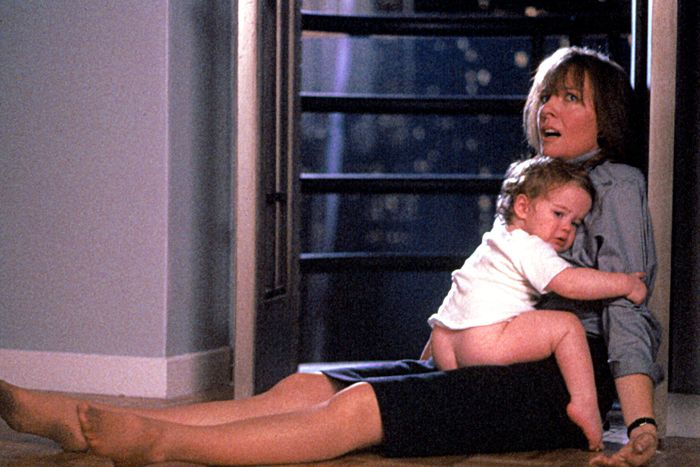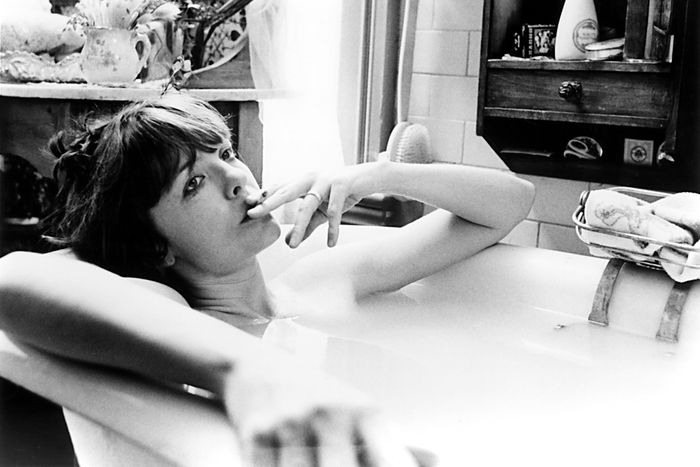Diane Keaton appeared in 60 films, performed more than two dozen television parts, earned four Best Actress Oscar nominations (and one win, for 1977’s Annie Hall), accrued multiple directing credits (including an episode of Twin Peaks), and wielded seismic influence on women’s fashion. All of it was driven by a quest to understand and embody beauty — a word that haunted her since her father told her on her 15th birthday that she was pretty. Keaton didn’t want to be pretty. She wanted to be beautiful.
As the Los Angeles native recalled in one of her eight books, a memoir titled Let’s Just Say it Wasn’t Pretty, Keaton loathed the word. She hated it when her mother, a housewife and amateur photographer, told her she had a pretty smile. And she hated it when a teacher complimented her on a pretty dress. “I was old enough to understand that pretty was a poor cousin to beautiful,” Keaton writes. “Pretty was the right dress from Bullock’s department store, not a beatnik tunic with black tights and a beret. Pretty was Sandra Dee, easy and light. Pretty fades.” But beautiful, Keaton continues, “makes you come back for more. It makes you ask questions. It’s vast, unknowable, and magnificent … I’ve been chasing it ever since.”
Cinema, popular culture, fashion, and the general perception of women’s attractiveness all benefited from Keaton’s lifelong creative mission. The remarkable consistency of her life’s work came from her understanding of coded languages and the difference between superficiality and profundity, the fleeting and the eternal. Her restless mind ultimately found beauty in men’s clothes from secondhand stores, in prewar Los Angeles buildings (she served on the board of the L.A. Conservancy and narrated their ads and historical videos), in non-prescription reading glasses (she had her own line, Keaton Readers), and in vivid speculations about what holds meaning in this life on earth and what comes after it. Her first movie as director, 1987’s Heaven, is a quasi-experimental work made up of old movie clips, newsreel and documentary snippets, and ruminations on eternity by a couple dozen interviewees, including her mother Dorothy and her sister Dorrie. “I see him as Groucho Marx,” one woman tells Keaton, the him being God. “He’s always playing tricks on us.”
So was Keaton, in her way. By the time she died at the age of 79, she had as strong a star persona as her original screen fashion idol Katharine Hepburn — the kind that made inattentive viewers assume she was just playing herself. After making her Broadway debut in Hair — in which she notably refused to appear onstage naked, even though it would’ve earned her an extra $50 per show — Keaton became a lead in comedies that showcased her gift for making elaborately scripted dialogue sound spontaneous. Her repetitions and stammerings and strange inflections were very much her own, as a perusal of her interviews will attest. Some viewers wrongly assumed this way of speaking was learned from her first celebrity boyfriend Woody Allen, who directed her in eight movies, stretching from 1972’s Play it Again, Sam through 1993’s Manhattan Murder Mystery (and whom she continued to support after he was accused of abuse, telling The Guardian, “I have nothing to say about that, except: I believe my friend”). The adjective “ditzy” clung to her, mainly because of her work in early Allen films, most notably Annie Hall, where the character’s signature phrase is, “Well, la-dee-dah, la la.”
In later comedies like First Wives’ Club, The Family Stone, the Father of the Bride movies, and a string of sixtysomething romcoms (including Something’s Gotta Give, in which Jack Nicholson’s aging lothario and Keanu Reeves’ goodhearted young doctor compete for her affections) Keaton continued to play oddballs with a peculiar way of talking, though none were trivial or stupid. Her advertising executive J.C. Wiatt in Baby Boom is a c-suite powerhouse with a corner office who loses her job and her boyfriend after adopting a baby, then moves to the country, creates a gourmet applesauce business, and snags a country doctor played by Sam Shephard. Carol Lipton in Manhattan Murder Mystery is a human encyclopedia of grisly crimes. Sonja in Love and Death is an 18th century Russian woman who must hide her brilliance from a sexist society. Her showstopping monologue, delivered more to herself than her lover, is an all-timer of pretzel logic: “To love is to suffer. To avoid suffering one must not love, but then one suffers from not loving. Therefore, to love is to suffer, not to love is to suffer, to suffer is to suffer. To be happy is to love, to be happy then is to suffer but suffering makes one unhappy; therefore, to be unhappy one must love or love to suffer or suffer from too much happiness. I hope you’re getting this down.”

Diane Keaton in Baby Boom. Photo: United Artists/Courtesy Everett Collection
As brilliant as she was in comedy, Keaton was formidable in drama. In the psychological thriller Looking for Mr. Goodbar, she’s wrenching as a self-destructive schoolteacher whose one-night stands are a delayed rebellion against her stifling Christian upbringing. (Keaton, who grew up in a household so devout that she ratted out her brother for having Playboy in his room, brought a lot of her own experiences to the part; the character was a once-repressed Jewish woman in Judith Rossner’s novel.) She plays the subdued-to-rebellious arc in a different time period in writer-director Gillian Armstrong’s period piece Mrs. Soffel, the true story of a 19th century farm woman who falls in love with a prison inmate (Mel Gibson) and helps him and his brother (Matthew Modine) escape. Less successfully, she played a left-wing actress modeled on Jane Fonda and Vanessa Redgrave who gets used by the CIA as well as the Palestine Liberation Army in The Little Drummer Girl. The Good Mother was a good try at a legal drama about a woman whose lover is accused of indecency with her young daughter. (This was four years before the Allen accusations.) On television, she was a fanatical nun in the movie version of the hit play Sister Mary Explains It All, a poor mother scrambling to supper her kids in On Thin Ice, and the friend and advocate of convicted murderer Karla Faye Tucker (Jennifer Jason Leigh) in Crossed Over. Of course, she was a nun again in the hallucinogenically gorgeous HBO drama The Young Pope (opposite Jude Law).
Click here to preview your posts with PRO themes ››
The peak for Keaton the dramatic actress is probably 1981’s Reds — the true story of the tumultuous relationship between writers John Reed and Louise Bryant during the rise of Communism, costarring, written, produced, and directed by another of Keaton’s famous lovers, Warren Beatty. As Louise, Keaton’s fierce intelligence and refusal to be bamboozled gives unifying shape to a sprawling epic, and makes you believe that both Beatty’s John “Jack” Reed and Nicholson’s alcoholic playwright Eugene O’Neill would be madly in love with her. When Jack goes to Russia, proving yet again that his lust for political heroism eclipses any love he professes to Louise, Eugene quietly tells her, “If you were mine, I wouldn’t share you with anybody … We’d be the center of it all.” And it’s not just Eugene wooing Louise. According to Peter Biskind’s biography Star: How Warren Beatty Seduced America, there was talk in Hollywood that Nicholson accepted the role in Reds because his former girlfriend Michelle Phillips had hooked up with Beatty after their relationship ended, and he was convinced he could steal Keaton away as payback. If so, the attempt failed. (There were rumors that Nicholson and Keaton did hook up during the shooting of Something’s Gotta Give, but Keaton said it never happened.)
She lost the Best Actress prize that year to her hero Hepburn (in On Golden Pond) and was similarly passed over for her work in Alan Parker’s classic 1982 film Shoot the Moon, a divorce drama written by Bo Goldman (Scent of a Woman). The movie co-stars Albert Finney as an acclaimed and hot-tempered writer named George and Keaton as Faith, the wife and mother of his children, who gave up her own dreams to support him, only to get thrown over for a younger woman (Karen Allen). Keaton’s Faith is a teakettle who simmers until she erupts in justified fury. The scene where Faith slumps in a bathtub after the separation, smoking a joint and singing The Beatles’ “If I Fell,” is a shattering depiction of the toll divorce takes on people’s ability to function. The New Yorker’ critic Pauline Kael’s review called her “a star without vanity. She’s so completely challenged by the role of Faith that she only cares about getting the character right.”

Diane Keaton in Shoot the Moon. Photo: MGM/Courtesy Everett Collection
Keaton was also, of course, Kay Adams-Corleone in Francis Ford Coppola’s The Godfather trilogy. It was male dominated through-and-through — a fact that Keaton mentioned often in interviews in which she effusively praised her male costars but lamented the paucity of opportunities for actresses in general, especially those over 40. She got a long on-again, off-again relationship with Al Pacino out of it, and it was unexpectedly rekindled during the shooting of The Godfather Part III, which includes a weird but charming scene where Pacino’s Michael Corleone picks up his estranged wife while dressed as a chauffeur. The scene is loosely derived from an incident during the shooting of The Godfather Part II, when Pacino told Keaton that he never had a driver’s license because he spent his whole life in New York City, and she taught him to drive in the parking lot of a casino. Even if Coppola didn’t understand Keaton’s importance to the series, Keaton did. According to Michael Schumacher’s Francis Ford Coppola: A Filmmakers’ Life, she requested $3 million for The Godfather, Part III, the same amount that Robert Duvall asked for and walked when he didn’t get it. She settled for $1.7 million, 48 times her salary for Godfather I.
In the end, Keaton became the rare female star whose name could reliably open a movie — not just when she was young, but well into her 60s. Women of her generation were arguably as loyal to her as men of Clint Eastwood’s, turning out to see Something’s Gotta Give (her first fully nude appearance, at 57) as well as Because I Said So, Mama’s Boy, Morning Glory, Love the Coopers, and three Book Club movies (part of a 21st century wave of ensemble comedies teaming up female stars from earlier eras). One characteristic of beauty is that it draws and holds attention regardless of the social taboos or aesthetic standards of the moment. Keaton’s radiance was living proof.
So many of Keaton’s movies seemed better off for their ability to surrender to her totalizing beauty. Famously, the original title of Annie Hall was Anhedonia (meaning an inability to experience pleasure), but was changed to reflect Keaton’s dominant presence (and her actual family name, Hall). The movie bent itself around her in other ways. It included her preferred wardrobe of vests, ties, fitted waistcoats, and hats. It included her favorite songs to sing. The original cut ran nearly two-and-a-half hours, and according to its editor, Ralph Rosenblum, was a shapeless mass of bits, loosely linked by the hero’s relationship with Annie. “And so we began cutting in the direction of that relationship,” he wrote in When the Shooting Stops … The Cutting Begins. Allen reportedly resisted. He kept shooting more scenes with his character Alvy Singer, perhaps hoping to move the needle back in his own direction. But he finally gave in and accepted that what Anhedonia wanted to be was Annie Hall, a movie about Diane Keaton, beautiful as ever.


